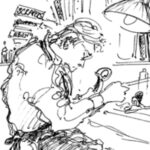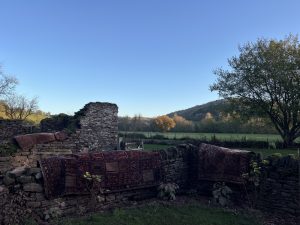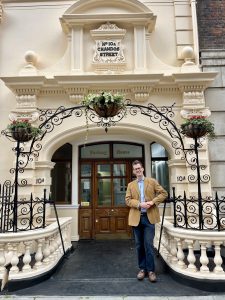John Lott

There is always so much to say about John Lott.
By some way he is the most colourful and intriguing characters in violin making, thanks to the contemporary description of his life by the writer and violin enthusiast Charles Reade.
The violin on the desk now is one of his wonderful Guarneri del Gesu copies. It looks a little tired, but is in wonderfully original condition. It even has it’s original neck, but there is a typical surprise there; it has been blocked out and extended, and a large peg pushed through the root. When the violin was made in the mid-nineteenth century, this procedure was already obsolete. You cannot help but think that it was Lott deliberately blurring authenticity and imitation.
It is a very careful reproduction of a 1735 period del Gesu. The traced outline fits like a fine glove over that of the ‘King’ Guarneri of that date. And interestingly, Lott was involved in the sale of that very violin, negotiating it’s purchase in 1857 from the collection of the late James Goding for the Vicomte de Janzé through Lott’s friend and colleague J.B.Vuillaume. Unfortunately for that story, the choice of materials and the detail work points more towards the ‘Plowden’ of the same year, which was also in London in the hands of John Hart at about the same time. But knowing Lott’s ingenuity it would be no surprise that he took elements of both, and others, to make a ‘unique’ Guarneri. It is not what we would nowadays call ‘a bench copy’. The most striking thing about this one perhaps is the way the deeply gouged edges and extravagant hooked corners capture the character of del Gesu in this period, in a natural and unforced way. Lott clearly had a very sophisticated grasp of style and technique.
Lott’s father, also John Lott, was of a German family which settled in London, probably in the mid eighteenth century. This may have helped him become acquainted with Bernhard Simon Fendt, also of German origin, and find a job with Thomas Dodd as a violin maker. By 1835 he was working independently in Covent Garden, with his son John, who was born on 1804. But by 1823, the younger John was impatient and dissatisfied with life in the workshop, which is how Charles Reade’s biography ‘Jack of All Trades’ got its title. Though slightly garnished- Reade was a successful novelist after all, the stated facts largely stand up to research. It is true that John Lott spent the next twenty or so years of his life working in a circus, as the trainer and companion of an elephant named Madame Djek. There are few other violin makers you can say that about. None, in fact. Poor old Madame Djek was accidentally shot by one of the circus’ cannons, and by 1851 Lott was back in London, at the workbench.
While travelling, he’d picked up the French language, and it was this that brought him close to Vuillaume, who was doing a lot of business in London at that time. He almost certainly came into contact with Tarisio too.
In 1831, Paganini had made his spectacularly successful tour of England, extracting never-before heard sounds from his 1743 del Gesu he called ‘Il Cannone’. All of a sudden, the work of the previously overlooked Giuseppe Guarneri became all the rage. Every violinist in England (possibly…) wanted to sound and play like Paganini, and they all wanted a del Gesu like his. It might also be said that few people actually knew what they really looked like. John Lott did, and he set about making them. Whether any of them were actually meant to deceive or just sold as replicas cannot really be known. The ones that he fashioned out of left-over parts of other violins do look rather suspicious it has to be said. But Lott thrived making violins, viols and cellos with an antiqued finish, some quite audaciously battered- although after the passage of the best part of two hundred years, it is hard to work out quite what Lott did to the varnish and what time and use has contributed in the usual way.
What has persisted is the reputation for tone. Lott knew how to make a violin perfectly well, and by following Stradivari and Guarneri arching and patterns so faithfully, he produced unquestionably great instruments for performance. His business practices do not seem to have been questioned or criticised in his own time. In ‘Jack of All Trades’ Charles Reade set out to portray a buccaneer of violin making, a larger-than-life character who deserved his success. In life, he had his portrait painted, and his shop sign and tools are preserved in the Horniman Museum in London, a sign of reverence almost, and certainly great respect for a great violin maker.
————————————————
The violin by John Lott is Lot 227 in our October Specialist Auction and can be viewed HERE.
Our Specialist Auction finishes on the 29th and 30th October.
To view the full catalogue please visit https://app.amati.com/en/auction/1127-amati-specialist-29th-30th-october
We are delighted to offer London viewing appointments in our new office alongside our usual two day viewing at The Langham.
Amati London
10A Chandos Street, W1G 9DQ
(just opposite The Langham)
London Viewing
Friday 24th & Saturday 25th – by appointment at Chandos Street
Sunday 26th & Monday 27th – at The Langham, 10am to 5pm
Tuesday 28th to Thursday 30th – by appointment at Chandos Street
For auction and viewing enquiries please email [email protected]




